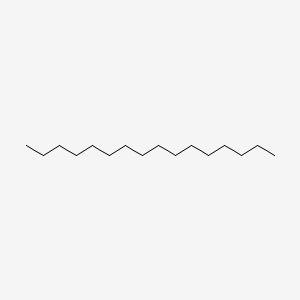| MeSH term | MeSH ID | Detail |
|---|---|---|
| Lupus Erythematosus, Systemic | D008180 | 43 associated lipids |
| Body Weight | D001835 | 333 associated lipids |
| Coronary Disease | D003327 | 70 associated lipids |
| Peritonitis | D010538 | 38 associated lipids |
| Hyperplasia | D006965 | 34 associated lipids |
| Glomerulonephritis | D005921 | 35 associated lipids |
| Encephalomyelitis, Autoimmune, Experimental | D004681 | 26 associated lipids |
| Keratosis | D007642 | 9 associated lipids |
| Serratia Infections | D016868 | 2 associated lipids |
Hexadecane
Hexadecane is a lipid of Fatty Acyls (FA) class. The involved functions are known as Analyte. The related lipids are Fatty Acids and palmitoleic acid.
Cross Reference
Introduction
To understand associated biological information of Hexadecane, we collected biological information of abnormalities, associated pathways, cellular/molecular locations, biological functions, related genes/proteins, lipids and common seen animal/experimental models with organized paragraphs from literatures.
What diseases are associated with Hexadecane?
There are no associated biomedical information in the current reference collection.
Possible diseases from mapped MeSH terms on references
We collected disease MeSH terms mapped to the references associated with Hexadecane
PubChem Associated disorders and diseases
What pathways are associated with Hexadecane
There are no associated biomedical information in the current reference collection.
PubChem Biomolecular Interactions and Pathways
Link to PubChem Biomolecular Interactions and PathwaysWhat cellular locations are associated with Hexadecane?
There are no associated biomedical information in the current reference collection.
What functions are associated with Hexadecane?
Related references are published most in these journals:
| Function | Cross reference | Weighted score | Related literatures |
|---|
What lipids are associated with Hexadecane?
Related references are published most in these journals:
| Lipid concept | Cross reference | Weighted score | Related literatures |
|---|
What genes are associated with Hexadecane?
There are no associated biomedical information in the current reference collection.
What common seen animal models are associated with Hexadecane?
There are no associated biomedical information in the current reference collection.
NCBI Entrez Crosslinks
All references with Hexadecane
Download all related citations| Authors | Title | Published | Journal | PubMed Link |
|---|---|---|---|---|
| pmid: | ||||
| TodosiÄchuk SR et al. | [Effect of carbon source and cultivation temperature on growth limitation of Candida tropicalis by biotin]. | 1976 May-Jun | Mikrobiologiia | pmid:1004244 |
| Glazunova LM and Finogenova TV | [Enzyme activity of citrate, glyoxylate and pentosephosphate cycles during synthesis of citric acids by Candida lipolytica]. | 1976 May-Jun | Mikrobiologiia | pmid:1004246 |
| Gogoleva EV et al. | [Optimization of the culture medium and role of its components in the biosynthesis of exopolysaccharides by Mycobacterium lacticolum]. | 1976 Sep-Oct | Mikrobiologiia | pmid:1004265 |
| Lang S and Wullbrandt D | Rhamnose lipids--biosynthesis, microbial production and application potential. | 1999 | Appl. Microbiol. Biotechnol. | pmid:10077819 |
| Sekelsky AM and Shreve GS | Kinetic model of biosurfactant-enhanced hexadecane biodegradation by Pseudomonas aeruginosa. | 1999 | Biotechnol. Bioeng. | pmid:10099620 |
| Berthe-Corti L and Ebenhöh W | A mathematical model of cell growth and alkane degradation in Wadden Sea sediment suspensions. | 1999 | BioSystems | pmid:10193758 |
| Bouchez-Naïtali M et al. | Diversity of bacterial strains degrading hexadecane in relation to the mode of substrate uptake. | 1999 | J. Appl. Microbiol. | pmid:10196747 |
| Bertrand JC et al. | [Isolation and study of a new marine bacterium growing on hydrocarbons. I. Physiological study (author's transl)]. | 1976 | Ann. Microbiol. (Paris) | pmid:1020874 |
| Jwanny EW and Hussein MM | Carbohydrates from hydrocarbons. II. Free and bound sugars from yeast cells grown on n-hexadecane. | 1976 | Acta Biol Acad Sci Hung | pmid:1025983 |
| Bruns A and Berthe-Corti L | Fundibacter jadensis gen. nov., sp. nov., a new slightly halophilic bacterium, isolated from intertidal sediment. | 1999 | Int. J. Syst. Bacteriol. | pmid:10319463 |
| Ziegenmeyer J et al. | [Local anesthesia after percutaneous application. II]. | 1976 | Arch Int Pharmacodyn Ther | pmid:1037080 |
| So CM and Young LY | Isolation and characterization of a sulfate-reducing bacterium that anaerobically degrades alkanes. | 1999 | Appl. Environ. Microbiol. | pmid:10388691 |
| Yakimov MM et al. | Characterization of antarctic hydrocarbon-degrading bacteria capable of producing bioemulsifiers. | 1999 | New Microbiol. | pmid:10423744 |
| Ko SH and Lebeault JM | Effect of a mixed culture on co-oxidation during the degradation of saturated hydrocarbon mixture. | 1999 | J. Appl. Microbiol. | pmid:10432589 |
| Parkes J | Cracking anaerobic bacteria. | 1999 | Nature | pmid:10499571 |
| Riviere JE et al. | Dermal absorption and distribution of topically dosed jet fuels jet-A, JP-8, and JP-8(100). | 1999 | Toxicol. Appl. Pharmacol. | pmid:10502503 |
| Busch S et al. | Identification and characterization of ComE and ComF, two novel pilin-like competence factors involved in natural transformation of Acinetobacter sp. strain BD413. | 1999 | Appl. Environ. Microbiol. | pmid:10508090 |
| Zhang L et al. | The preventive effects of incomplete Freund's adjuvant and other vehicles on the development of adjuvant-induced arthritis in Lewis rats. | 1999 | Immunology | pmid:10540226 |
| Levine S and Saltzman A | Ascites produced in rats without tubercle bacilli or tumor cells. | 1999 Sep-Dec | Immunol. Invest. | pmid:10574628 |
